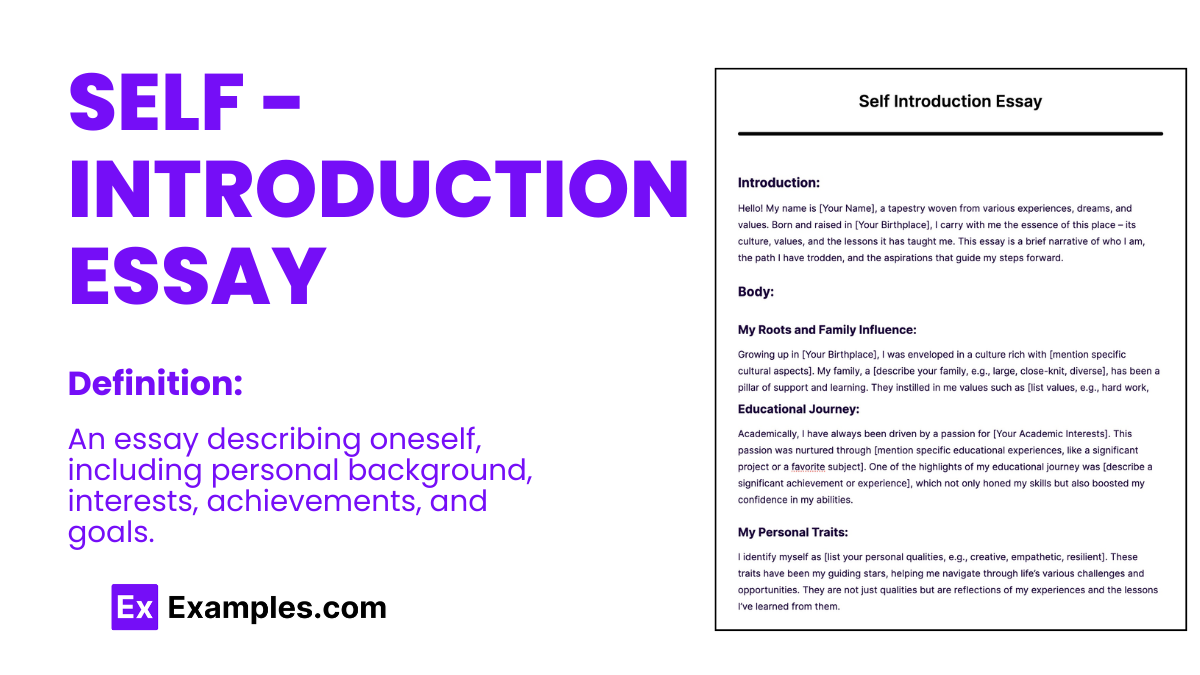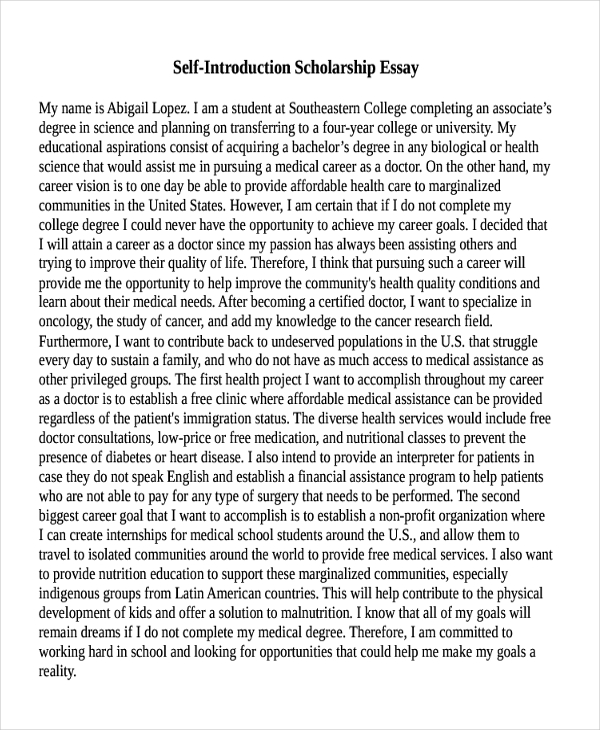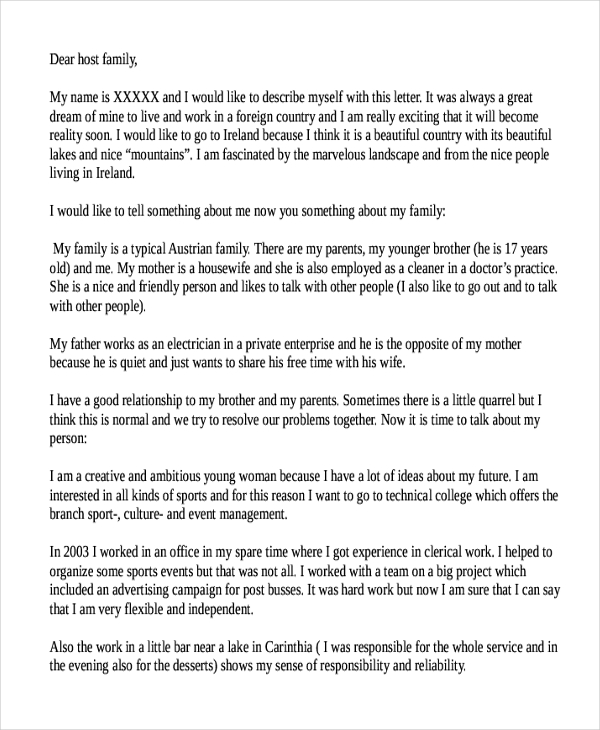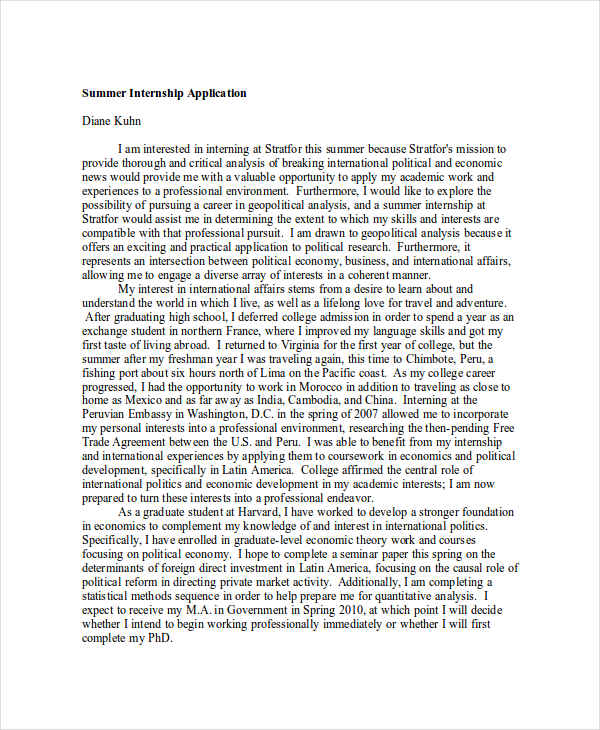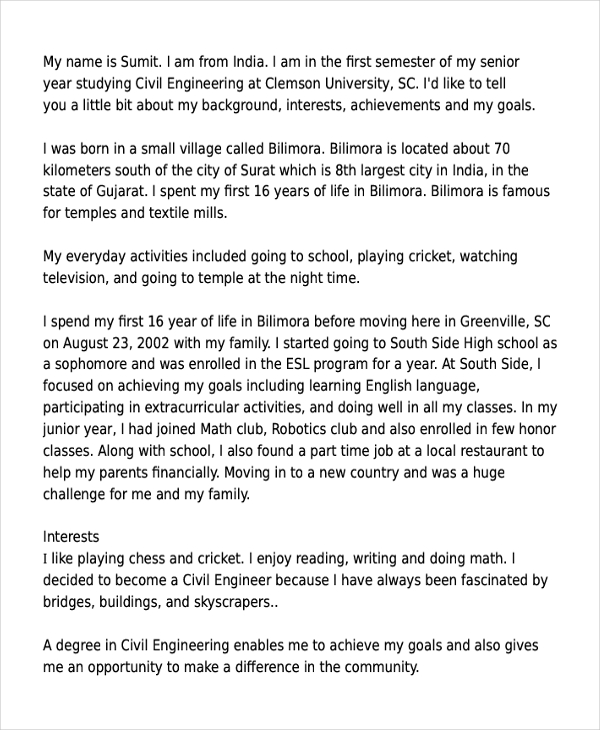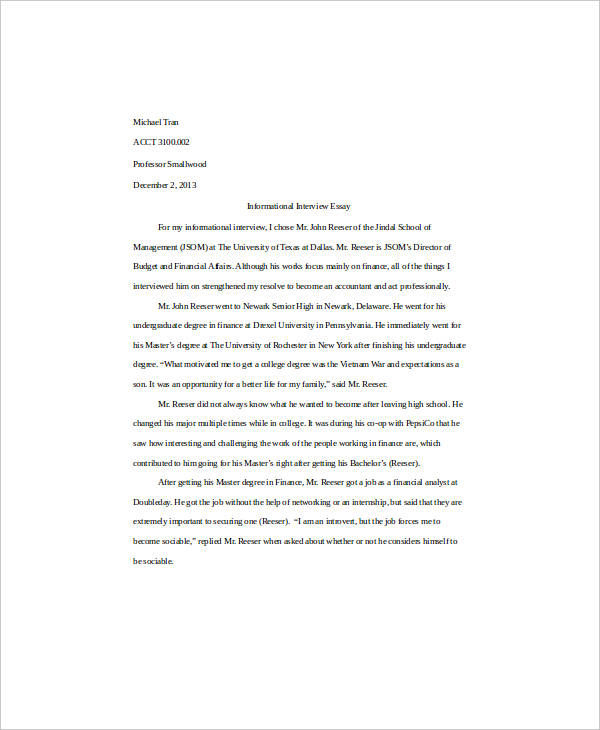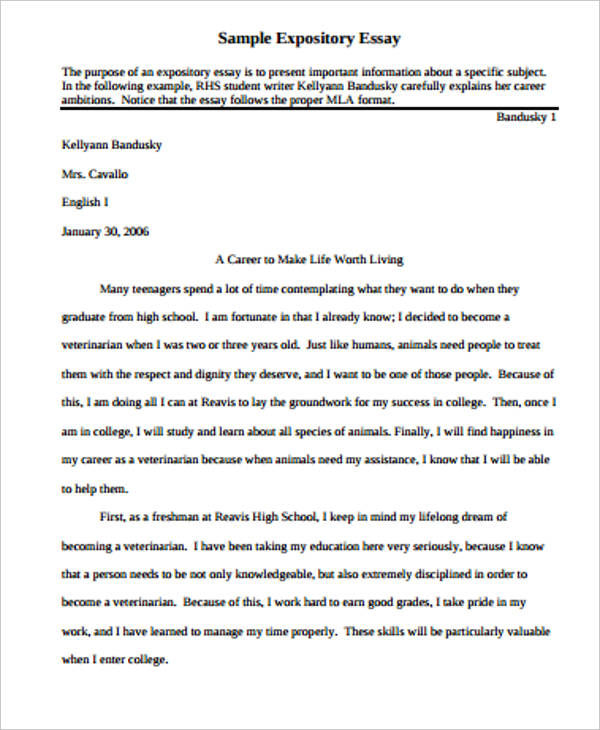15+ Self-Introduction Essay Examples to Download
A Self Introduction Essay is a window into your personality, goals, and experiences. Our guide, supplemented with varied essay examples, offers insights into crafting a compelling narrative about yourself. Ideal for college applications, job interviews, or personal reflections, these examples demonstrate how to weave your personal story into an engaging essay. Learn to highlight your strengths, aspirations, and journey in a manner that captivates your readers, making your introduction not just informative but also memorable.
What is Self Introduction Essay?
A self-introduction essay is a written piece where you describe yourself in a personal and detailed way. It’s a way to introduce who you are, including your name, background, interests, achievements, and goals. This type of essay is often used for college or job applications, allowing others to get to know you better. It’s an opportunity to showcase your personality, experiences, and what makes you unique. Writing a self-introduction essay involves talking about your educational background, professional experiences if any, personal interests, and future aspirations. It’s a chance to highlight your strengths, achievements, and to share your personal story in a way that is engaging and meaningful.
Do you still remember the first time you’ve written an essay? I bet you don’t even know it’s called an “essay” back then. And back then you might be wondering what’s the purpose such composition, and why are you writing something instead of hanging out with your friends.
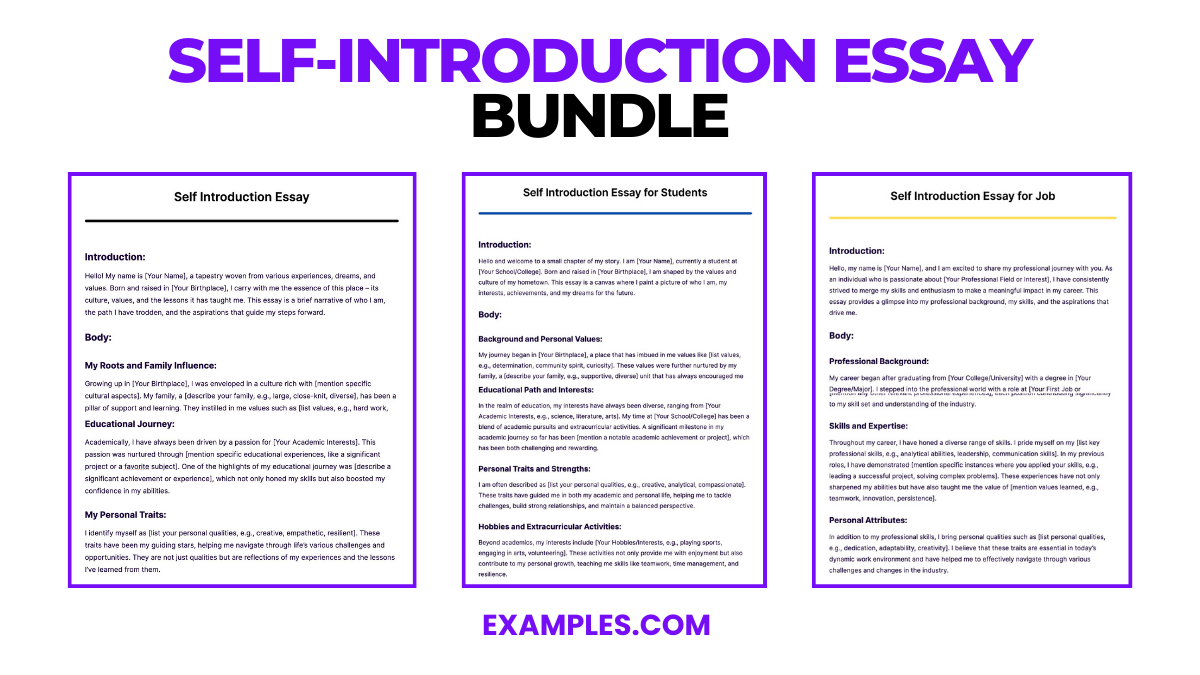
Download Self-Introduction Essay Bundle
Now, you probably are already familiar with the definition of an essay, and the basics of writing one. You’re also probably aware of the purpose of writing essays and the different writing styles one may use in writing a composition. Here, we will be talking about self-introduction essay, and look into different example such as personal essay which you may refer to.
Self Introduction Essay Format
Introduction
- Start with a hook: Begin with an interesting fact, a question, or a compelling statement about yourself to grab the reader’s attention.
- State your name and a brief background: Share your name, age, and where you’re from or what you currently do (student, job role).
Educational Background
- Discuss your current or most recent educational experience: Mention your school, college, or university and your major or area of study.
- Highlight academic achievements or interests: Share any honors, awards, or special projects that are relevant to your personality or career goals.
Professional Background
- Mention your current job or professional experiences: Briefly describe your role, company, or the type of work you do.
- Highlight relevant skills or achievements: Share experiences that showcase your abilities and contributions to your field.
Personal Interests and Goals
- Share your hobbies or interests: Briefly describe activities you enjoy or passions you pursue outside of work or school.
- Discuss your short-term and long-term goals: Explain what you aim to achieve in the near future and your aspirations for the long term.
Conclusion
- Summarize your strengths and what makes you unique: Reinforce key points about your skills, achievements, or character.
- Close with a statement on what you hope to achieve or contribute in your next role, educational pursuit, or personal endeavor.
Example of Self Introduction Essay in English
Hello! My name is Alex Johnson, a 21-year-old Environmental Science major at Green Valley University, passionate about sustainable living and conservation efforts. Raised in the bustling city of New York, I’ve always been fascinated by the contrast between urban life and the natural world, driving me to explore how cities can become more sustainable.
Currently, in my final year at Green Valley University, I’ve dedicated my academic career to understanding the complexities of environmental science. My coursework has included in-depth studies on renewable energy sources, water conservation techniques, and sustainable agriculture. I’ve achieved Dean’s List status for three consecutive years and led a successful campus-wide recycling initiative that reduced waste by 30%.
This past summer, I interned with the City Planning Department of New York, focusing on green spaces in urban areas. I worked on a project that aimed to increase the city’s green coverage by 10% over the next five years. This hands-on experience taught me the importance of practical solutions in environmental conservation and sparked my interest in urban sustainability.
Beyond academics, I’m an avid hiker and nature photographer, believing strongly in the power of visual storytelling to raise awareness about environmental issues. My goal is to merge my passion for environmental science with my love for photography to create impactful narratives that promote conservation.
In the future, I aspire to work for an NGO that focuses on urban sustainability, contributing to projects that integrate green spaces into city planning. I am also considering further studies in environmental policy, hoping to influence positive change on a global scale.
My journey from a curious city dweller to an aspiring environmental scientist has been driven by a deep passion for understanding and protecting our natural world. With a solid educational foundation and practical experience, I am eager to contribute to meaningful environmental conservation efforts. I believe that by combining scientific knowledge with creative communication, we can inspire a more sustainable future for urban areas around the globe.
Self-Introduction Essay
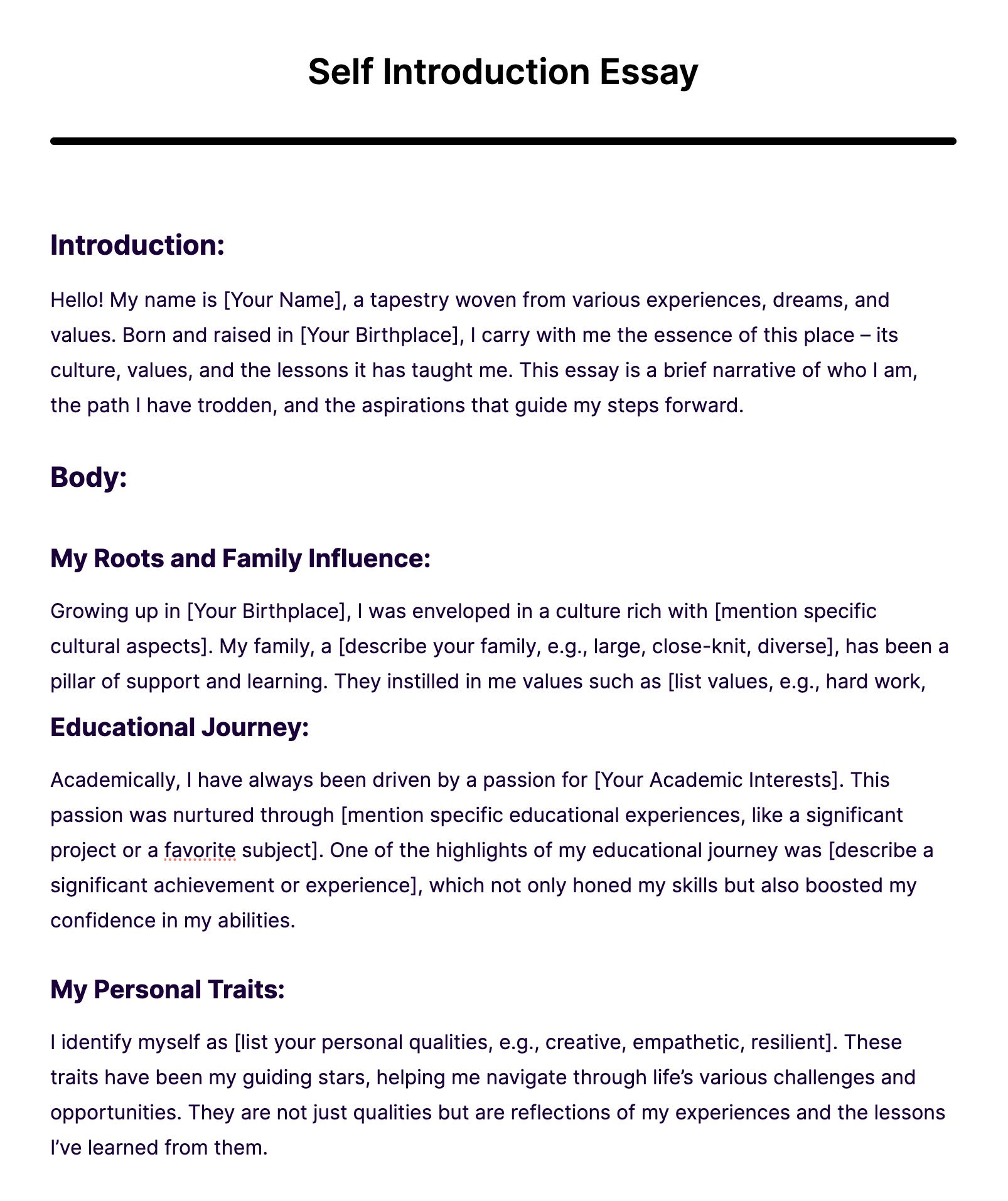
Self Introduction Essay for Job
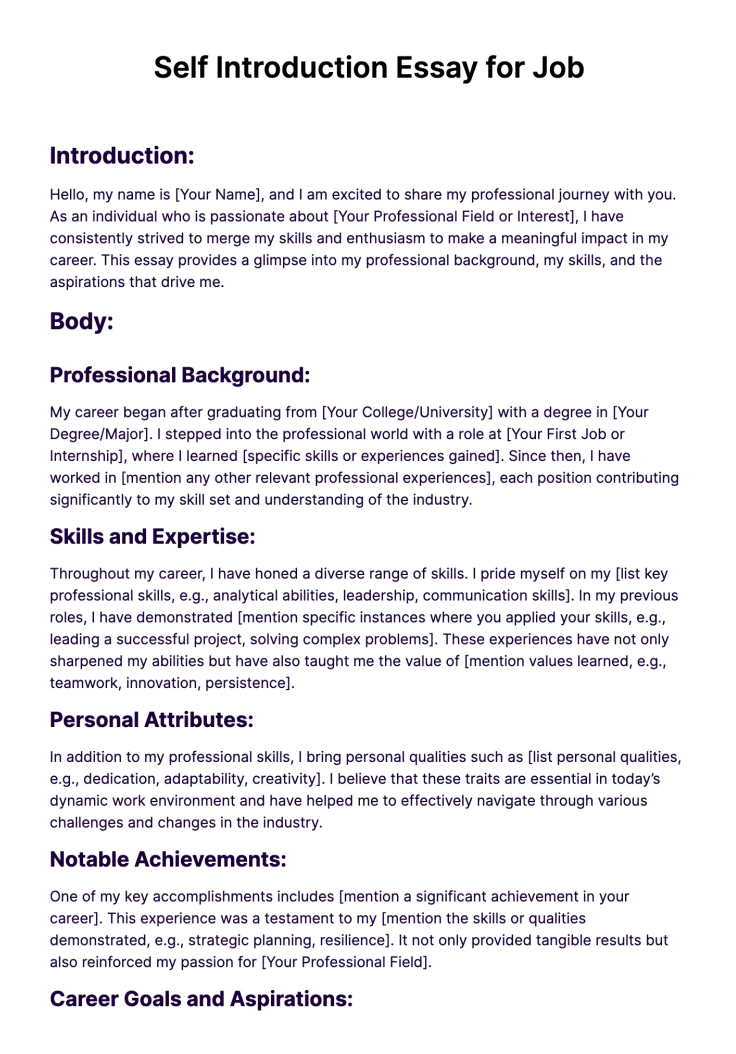
Self Introduction Essay for Students
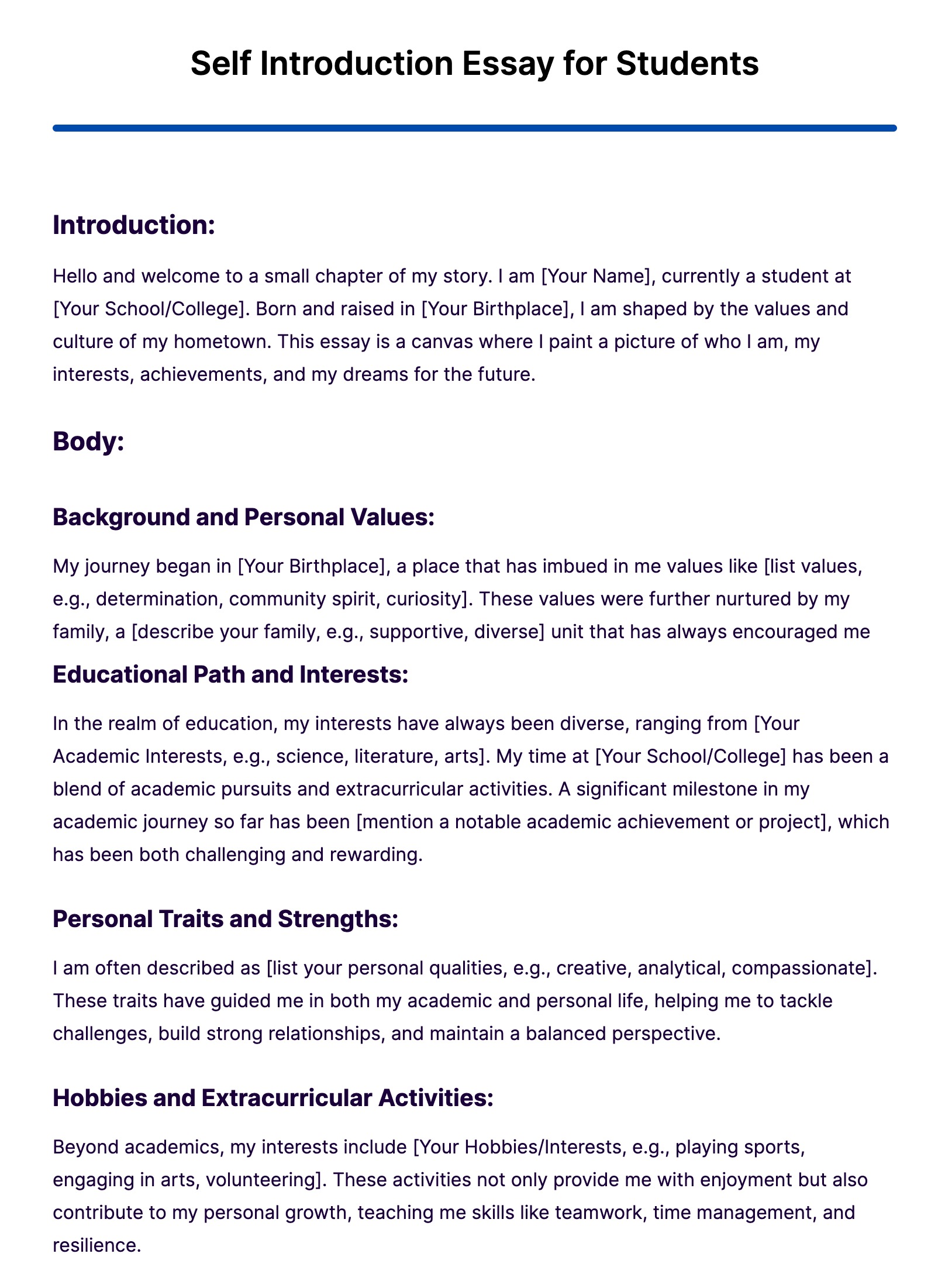
Self Introduction Essay Example

Self Introduction For College Students Example

Simple Self Introduction For Job Example
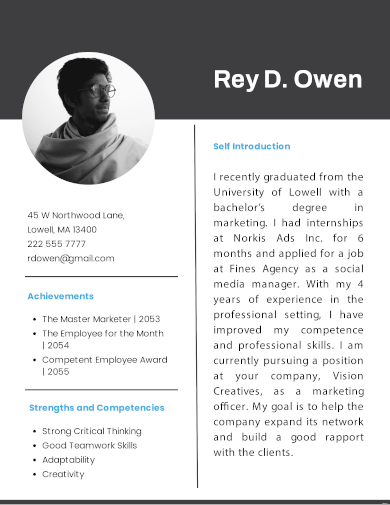
Free Self Introduction For Kids Example
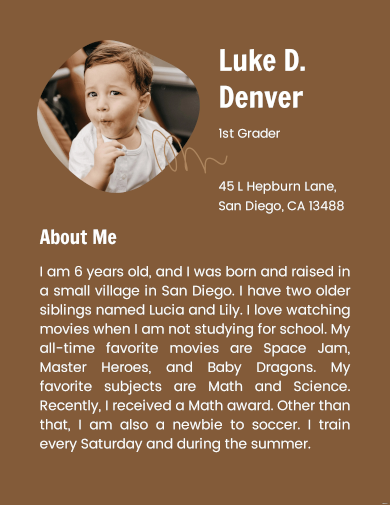
Simple Self Introduction Example
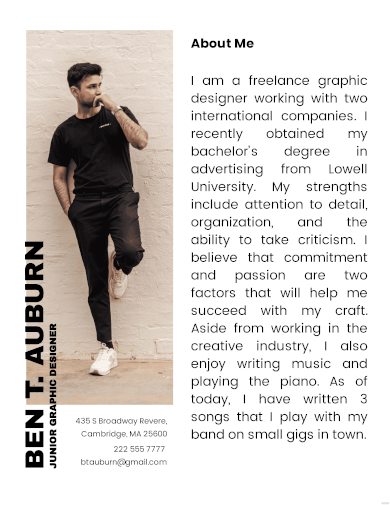
Self Introduction For Freshers Example

Free Self Introduction For Interview Example

Company Self Introduction Example
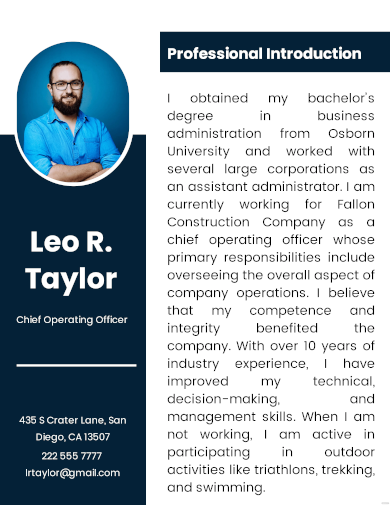
Self Introduction For First Day At Work Sample
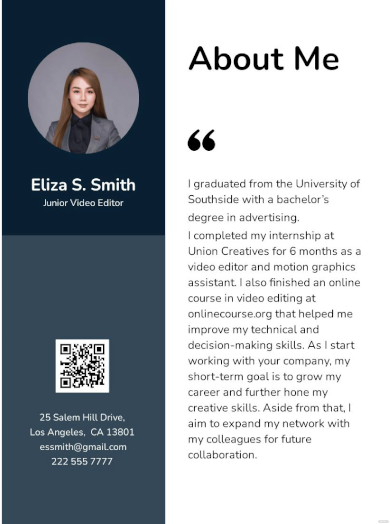
Sample Self Introduction for Scholarship Example
Free Self Introduction Sample Example
Creative Essay for Internship Example
What to Write in a Self-Introduction Essay
A self-introduction essay, as the name suggest, is an part of an essay containing the basic information about the writer.
In writing a self-introduction essay, the writer intends to introduce himself/herself by sharing a few personal information including the basics (e.g. name, age, hometown, etc.), his/her background information (e.g. family background, educational background, etc.), and interesting facts about him/her (e.g. hobbies, interests, etc). A self-introductory essay primarily aims to inform the readers about a few things regarding the writer. You may also see personal essay examples & samples
How to Write a Self-Introduction Essay
A self-introduction essay is, in most cases, written using the first-person point of view. As a writer, you simply need to talk about yourself and nothing more to a specific audience. You may also like essay writing examples
A self-introduction essay can be easy to write, since all you have to do is to introduce yourself. However, one needs to avoid sounding like a robot or a person speaking in monotone. Of course, you need to make the composition interesting and engaging, instead of making it plain and bland. This is probably the main challenge of writing a self-introduction essay, and the first thing every writer needs to be aware of.
Free Essay Outline Worksheet Example
Free Interesting Self Introduction for Student Example
Free Attractive Introduction Essay for Interview Example
Formal Self Introduction Expository Example
Uses of Self Introduction Essay
- College Applications: Many universities and colleges ask for a self-introduction essay as part of the application process. This essay allows admissions officers to learn more about your personality, background, and aspirations beyond your grades and test scores.
- Scholarship Applications: When applying for scholarships, a self-introduction essay can help you stand out. It’s an opportunity to share your achievements, experiences, and the reasons you deserve the scholarship.
- Job Interviews: Preparing a self-introduction essay can be useful for job interviews. It helps you articulate your professional background, skills, and career goals clearly and confidently.
- Networking: In professional networking situations, having a polished self-introduction essay can help you quickly share relevant information about yourself with potential employers, mentors, or colleagues.
- Personal Reflection: Writing a self-introduction essay is a valuable exercise in self-reflection. It can help you understand your own goals, strengths, and weaknesses better.
- Online Profiles: For personal or professional websites, social media, or portfolios, a self-introduction essay provides a comprehensive overview of who you are and what you offer, attracting potential connections or opportunities.
Tips for Writing a Self-Introduction Essay
A self-introduction essay might be one of the easiest essays to start. However, one needs to learn a few things to make the composition worth reading. You might find a lot of tips online on how to write a self-introduction essay, but here are some tips which you might find useful.
1. Think of a catchy title
The first thing that attracts readers is an interesting title, so create one.
2. Introduce yourself
You can create some guide questions to answer like: Who are you? What are your interests? What is your story? Simply talk about yourself like you’re talking to someone you just met.
3. Find a focus
Your life story is too broad, so focus on something, like: What makes you unique?
4. Avoid writing plainly
For example, instead of saying: ‘I like listening to classical music’, you can say: ‘My dad gave me an album containing classical music when I was five, and after listening to it, I was really captivated. I’ve loved it since then.’ You may also check out high school essay examples & samples
5. Simplify your work
Use simple words and language. Write clearly. Describe details vividly.
6. End it with a punch
You cannot just plainly say ‘The End’ at the last part. Create a essay conclusion which would leave an impression to your readers.
7. Edit your work
After wrapping up, take time to review and improve your work. You may also see informative essay examples & samples
What is a Creative Self Introduction Essay?
1. Choose a Theme or Metaphor:
Start with a theme or metaphor that reflects your personality or the message you want to convey. For example, you could compare your life to a book, a journey, or a puzzle.
2. Engaging Hook:
Begin with an attention-grabbing hook, such as a captivating anecdote, a thought-provoking question, a quote, or a vivid description.
3. Tell a Story:
Weave your self-introduction into a narrative or story that highlights your experiences, values, or defining moments. Storytelling makes your essay relatable and memorable.
4. Use Vivid Imagery:
Employ descriptive language and vivid imagery to paint a picture of your life and character. Help the reader visualize your journey.
5. Show, Don’t Tell:
Instead of simply listing qualities or achievements, demonstrate them through your storytelling. Show your resilience, creativity, or determination through the narrative.
6. Include Personal Anecdotes:
Share personal anecdotes that showcase your character, challenges you’ve overcome, or moments of growth.
7. Express Your Passions:
Discuss your passions, interests, hobbies, or aspirations. Explain why they are important to you and how they have influenced your life.
8. Reveal Vulnerability:
Don’t be afraid to show vulnerability or share setbacks you’ve faced. It adds depth to your story and demonstrates your resilience.
9. Highlight Achievements:
Mention significant achievements, awards, or experiences that have shaped your journey. Connect them to your personal growth and values.
10. Convey Your Personality:
Use humor, wit, or elements of your personality to make your essay unique and relatable. Let your voice shine through.
11. Share Future Aspirations:
Discuss your goals, dreams, and what you hope to achieve in the future. Explain how your experiences have prepared you for your next steps.
12. Conclude with a Message:
Wrap up your essay with a meaningful message or reflection that leaves a lasting impression on the reader.
13. Revise and Edit:
After writing your initial draft, revise and edit your essay for clarity, coherence, and conciseness. Ensure it flows smoothly.
How do you write an introduction to a self essay?
1. Start with a Hook:
Begin with an engaging hook to capture the reader’s attention. This could be a personal anecdote, a thought-provoking question, a quote, or a vivid description. The hook should relate to the essay’s theme.
2. Introduce Yourself:
After the hook, introduce yourself by stating your name and any relevant background information, such as your age, place of origin, or current location. This helps provide context.
3. Establish the Purpose:
Clearly state the purpose of your self-essay. Explain why you are writing it and what you aim to convey. Are you introducing yourself for a job application, a college admission essay, or a personal blog? Make this clear.
4. Provide a Preview:
Offer a brief preview of the main points or themes you will address in the essay. This helps set expectations for the reader and gives them an overview of what to anticipate.
5. Share Your Thesis or Central Message:
In some self-essays, especially in academic or personal development contexts, you may want to state a central message or thesis about yourself. This is the core idea you’ll explore throughout the essay.
6. Express Your Voice:
Let your unique voice and personality shine through in the introduction. Write in a way that reflects your style and character. Avoid using overly formal or stilted language if it doesn’t align with your personality.
7. Be Concise:
Keep the introduction relatively concise. It should provide an overview without delving too deeply into the details. Save the in-depth discussions for the body of the essay.
8. Revise and Edit:
After writing the introduction, review it for clarity, coherence, and conciseness. Make sure it flows smoothly and leads naturally into the main body of the essay.
Here’s an example of an introduction for a self-essay:
“Standing at the threshold of my college years, I’ve often found myself reflecting on the journey that brought me here. I am [Your Name], a [Your Age]-year-old [Your Origin or Current Location], with a passion for [Your Interests]. In this self-essay, I aim to share my experiences, values, and aspirations as I enter this new chapter of my life. Through personal anecdotes and reflections, I hope to convey the lessons I’ve learned and the person I’m becoming. My central message is that [Your Central Message or Thesis]. Join me as I explore the highs and lows of my journey and what it means to [Your Purpose or Theme].”
What is a short paragraph of self introduction
“Hello, my name is [Your Name], and I am [Your Age] years old. I grew up in [Your Hometown] and am currently studying [Your Major or Grade Level] at [Your School or University]. I have always been passionate about [Your Interests or Hobbies], and I love exploring new challenges and experiences. In my free time, I enjoy [Your Activities or Hobbies], and I’m excited to be here and share my journey with all of you.”
How do I start my self introduction?
1. Greet the Audience:
Start with a warm and friendly greeting. This sets a positive tone and makes you approachable.
Example: “Good morning/afternoon/evening!”
2. State Your Name:
Clearly and confidently state your name. This is the most basic and essential part of any self-introduction.
Example: “My name is [Your Name].”
3. Provide Additional Background Information:
Depending on the context, you may want to share additional background information. Mention where you are from, your current location, or your job title, if relevant.
Example: “I’m originally from [Your Hometown], but I currently live in [Your Current Location].”
4. Express Enthusiasm:
Express your enthusiasm or eagerness to be in the situation or context where you are introducing yourself.
Example: “I’m thrilled to be here today…”
5. State the Purpose:
Clearly state the purpose of your self-introduction. Are you introducing yourself for a job interview, a social gathering, or a specific event? Make it clear why you are introducing yourself.
Example: “…to interview for the [Job Title] position.”
6. Offer a Brief Teaser:
Give a brief teaser or hint about what you’ll be discussing. This can generate interest and set the stage for the rest of the introduction.
Example: “I’ll be sharing my experiences as a [Your Profession] and how my background aligns with the requirements of the role.”
7. Keep It Concise:
Keep your introduction concise, especially in professional settings. You can provide more details as the conversation progresses.
8. Be Confident and Maintain Eye Contact:
Deliver your introduction with confidence and maintain eye contact with the audience or the person you’re addressing.
How can I start my self introduction example?
Hi, I’m [Your Name]. It’s a pleasure to meet all of you. I come from [Your Hometown], and today, I’m excited to tell you a bit about myself. I have a background in [Your Education or Profession], and I’m here to share my experiences, skills, and passions. But before I dive into that, let me give you a glimpse into the person behind the resume. So, here’s a little about me…”
For more insights on crafting a compelling self-introduction, the University of Nevada, Reno’s Writing & Speaking Center provides valuable resources. These can enhance your essay-writing skills, especially in crafting introductions that make a lasting impression.


